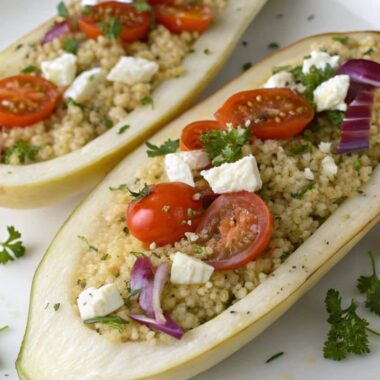Eggplant ripe and ready to cook can transform your meals from ordinary to extraordinary. Have you ever bought an eggplant, only to find it too bitter, mushy, or flavorless when you finally cooked it? Chances are, it wasn’t ripe. Picking a perfectly ripe eggplant is like finding the sweetest apple—it makes all the difference. Whether you’re grilling, roasting, or making a hearty stew, knowing how to choose a ripe eggplant is a must for delicious meals.
Table of Contents
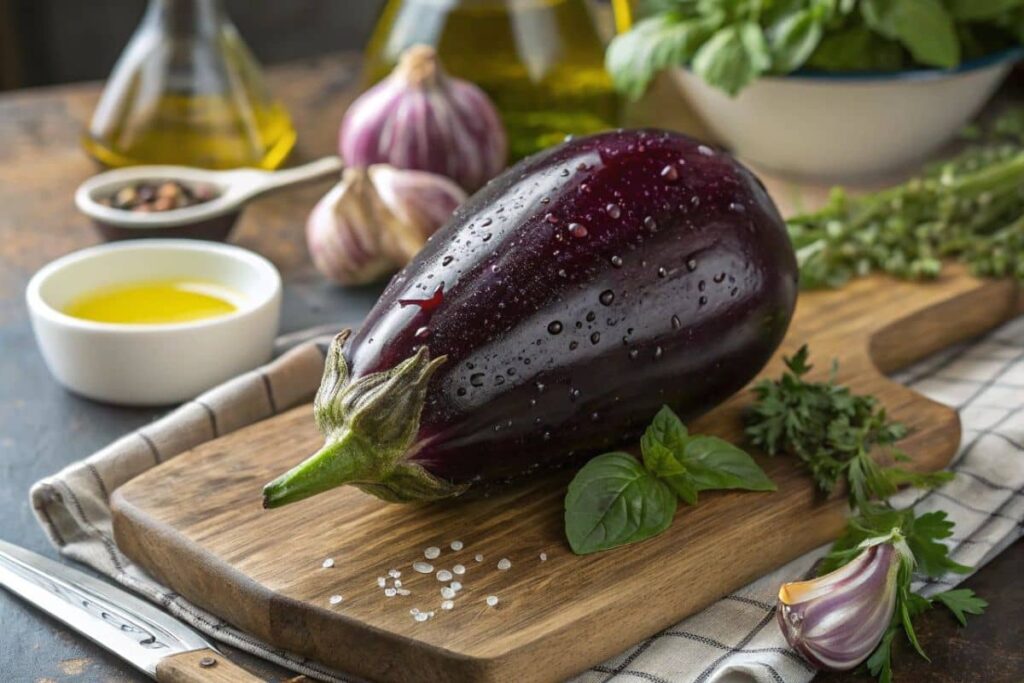
Choosing Ripe Eggplants
Why Ripe Eggplants Are Important for Cooking
The ripeness of an eggplant plays a crucial role in its taste, texture, and ability to soak up flavors in your recipes. When an eggplant is ripe, it offers a creamy, slightly sweet, and tender bite. However, using one that’s underripe or overripe can lead to disappointing results, such as bitterness or an overly mushy texture. Let’s explore how to identify when an eggplant is ripe for the perfect dish!
Common Misconceptions About Ripe Eggplant
Bigger isn’t always better when it comes to eggplants! While some assume that size indicates quality, smaller eggplants are often sweeter and more tender. And what about bruises? Don’t judge too quickly—while large bruises can signal spoilage, minor imperfections don’t necessarily mean the eggplant isn’t ripe or flavorful.
Physical Signs of a Ripe Eggplant
Want to tell if an eggplant is ripe? Start by giving it a good look. Its appearance can reveal a lot about its freshness and flavor potential.
The Skin: Shiny, Smooth, and Blemish-Free
First, examine the skin closely. An eggplant ripe for cooking will have a glossy, smooth surface. Dull or wrinkled skin often indicates it’s overripe or has been stored for too long. Look for eggplants free of major blemishes or discoloration, unless you’re planning to use them right away.
The Stem: Fresh and Green
The stem is like the eggplant’s health indicator. A green, fresh-looking stem means the vegetable was picked recently. If the stem is brown or shriveled, the eggplant might already be past its prime.
The Weight: Heaviness Means Freshness
Pick up the eggplant—it should feel heavy for its size. This means it’s fresh and full of moisture. Lightweight eggplants could be drying out on the inside.
The Touch Test: How Firm Should a Ripe Eggplant Be?
Touch is just as important as appearance when choosing an eggplant. But how do you know if you’ve found the perfect one? Gently press the skin—if it slightly springs back, that’s a good sign the eggplant ripe enough to use!
Gentle Pressure and Bounce Back
Give the eggplant a gentle press with your finger. If it slightly indents and bounces back, it’s ripe! If it feels rock-hard, it’s not ready yet. And if it stays indented, it’s likely overripe.
Avoiding Overly Soft or Hard Eggplants
Eggplants that are too soft may have started to spoil, while ones that are too hard may not have developed their full flavor. Aim for that perfect middle ground—it’s like testing an avocado for ripeness.
The Color Check: Perfect Hue for Ripeness
Color may vary by variety, but it’s a key indicator when identifying an eggplant ripe enough for cooking. Let’s explore what to look for in different types.
Identifying Ripe Colors in Different Eggplant Varieties
For traditional purple eggplants, a deep, vibrant shade is your best clue. If the color appears pale or faded, it’s likely underripe. For varieties like white or striped eggplants, ensure the color is rich and consistent, with no greenish undertones. A vivid hue is a clear sign of freshness and readiness!
Why Color Matters When Picking Eggplants
The right color reflects proper growth and flavor development. Eggplants that haven’t fully deepened in color can taste bitter, while overripe ones may turn bland or mushy. Trust the visual cues—nature uses color as its ripeness signal, making your selection process a breeze!
Tips for Picking the Best Eggplant at the Market
Shopping for the perfect eggplant? Follow these tips to ensure you choose an eggplant ripe and ready to elevate your dishes!
Timing Your Purchase: Seasonal Best Practices
Eggplants are at their peak during the summer and early fall. Buying them in season ensures maximum flavor and freshness. While out-of-season eggplants may look fine, they often lack the same rich taste and creamy texture. Stick to the right time of year for the best results.
Understanding Eggplant Varieties and When Eggplant Ripe for Cooking
Different types of eggplants have unique ripening characteristics. Japanese eggplants, with their slender shape, ripen quickly and are naturally tender. Italian eggplants, being plumper, require a bit more attention—look for firm skin and vibrant color to confirm ripeness. Knowing the variety makes selecting an eggplant ripe for your recipe so much easier!
| Eggplant Variety | Ripeness Indicator |
|---|---|
| Classic Purple | Deep purple color, firm with slight give |
| Japanese | Slender, shiny skin, vibrant purple hue |
| White | Bright white color, smooth skin |
How to Store Eggplant After Buying It
Picked an eggplant ripe and ready to use? Great! Now let’s ensure it stays fresh until it’s time to cook. Proper storage can make all the difference in maintaining its flavor and texture.
The Best Storage Practices to Maintain Freshness
For optimal freshness, store eggplants in a cool, dry place for up to 3 days. Avoid putting them in the fridge unless the weather is very hot, as cold temperatures can damage their texture and cause them to become spongy. Also, keep eggplants away from ethylene-producing fruits like bananas and apples to slow down over-ripening.
How Long Does a Ripe Eggplant Last?
A properly stored eggplant ripe and ready for cooking will usually last 3-5 days. Keep an eye on its skin—if it starts to wrinkle or feel too soft, it’s best to use it immediately to prevent waste. Quick action ensures you’ll enjoy its creamy texture and mild flavor in your favorite recipes!
Common Problems When Checking Eggplant Ripe Enough for Cooking
Even with the best tips, identifying when an eggplant ripe can feel tricky. Here are common problems you might face and how to solve them.
What to Do If an Eggplant Feels Too Soft?
If the eggplant feels overly soft, it’s likely overripe. While overripe ones aren’t ideal for all dishes, you can still use them in recipes like dips or soups where texture isn’t as important. Remove any seeds that look dark or slimy, as these can be bitter.
Signs of Overripe or Underripe Eggplants
An overripe eggplant may show brown spots or have seeds that are dark and hardened. On the other hand, one that’s underripe will feel too firm, with pale, bitter flesh inside. Aim for that sweet spot where the eggplant ripe is firm yet slightly yielding under pressure.
How to Salvage an Overripe Eggplant
Don’t toss that overripe eggplant just yet! Roast it with olive oil and garlic, then blend it into a creamy dip like baba ganoush. This method not only prevents waste but also transforms an overripe eggplant into a delicious, smoky treat that’s perfect for dipping or spreading.
Incorporating Eggplant Ripe and Ready into Your Favorite Recipes
When you find an eggplant ripe enough, it becomes an essential ingredient in countless recipes. Its creamy texture and mild flavor make it adaptable to various cuisines. From hearty casseroles to fresh salads, a ripe eggplant is a joy to cook with. Here are some creative ideas to get you started:
Why Ripe Eggplants Taste Better
Perfectly ripe eggplants achieve a harmonious balance of sweetness and nuttiness, elevating dishes like ratatouille, eggplant parmesan, or curries. Their tender flesh absorbs flavors beautifully, enhancing any marinade, spice blend, or herb pairing. Whether roasted, grilled, or sautéed, an eggplant ripe brings out the best in your culinary creations.
Easy Recipes for Fresh Eggplants
Cooking with fresh, ripe eggplants unlocks endless possibilities. Their velvety texture and mild flavor complement a variety of dishes. Here are three detailed recipes that highlight the versatility of an eggplant ripe and ready for your kitchen:
1. Grilled Eggplant with Garlic and Herbs
Grilling eggplant brings out its natural sweetness while giving it a smoky, charred flavor. This recipe is quick, simple, and perfect as a side dish or appetizer.
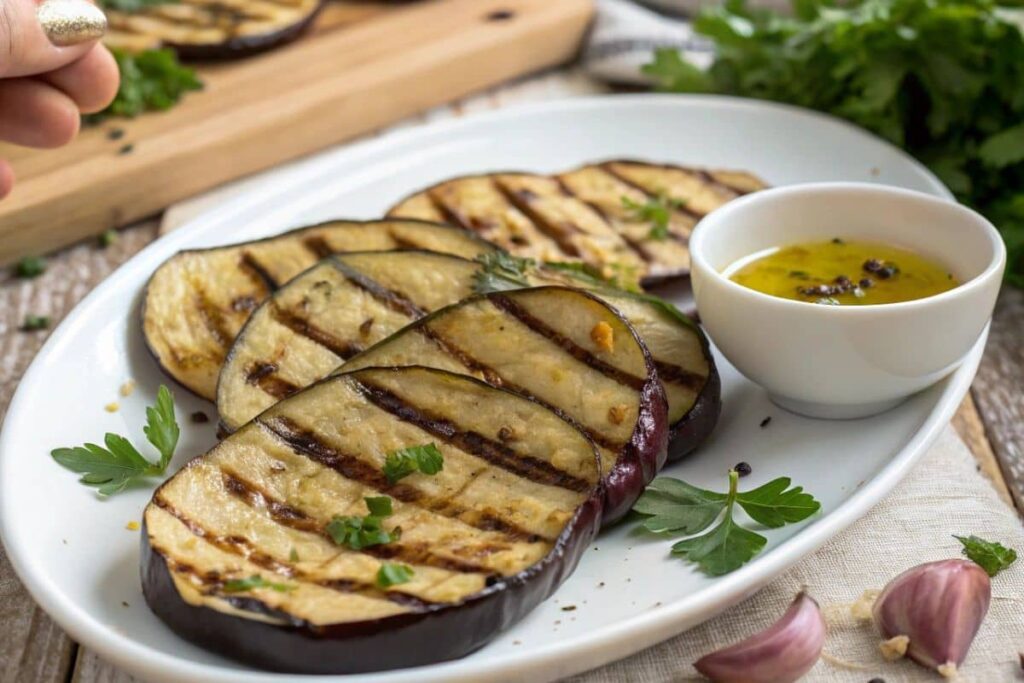
Ingredients:
- 2 medium eggplants
- 2 tablespoons olive oil
- 3 garlic cloves (minced)
- 1 teaspoon dried oregano
- 1 teaspoon salt
- ½ teaspoon black pepper
- Fresh parsley (chopped, for garnish)
Instructions:
- Preheat your grill to medium heat.
- Slice the eggplants into ½-inch-thick rounds.
- In a small bowl, mix olive oil, minced garlic, oregano, salt, and pepper.
- Brush the eggplant slices generously with the oil mixture on both sides.
- Place the slices on the grill and cook for 4-5 minutes per side, until they’re tender and have grill marks.
- Transfer to a serving plate, sprinkle with fresh parsley, and serve hot. Enjoy the smoky flavors paired with the freshness of the herbs!
2. Creamy Eggplant Pasta
Roasted eggplant makes an incredible pasta sauce that’s rich, creamy, and full of flavor. This vegetarian recipe is hearty and satisfying, perfect for a cozy dinner.
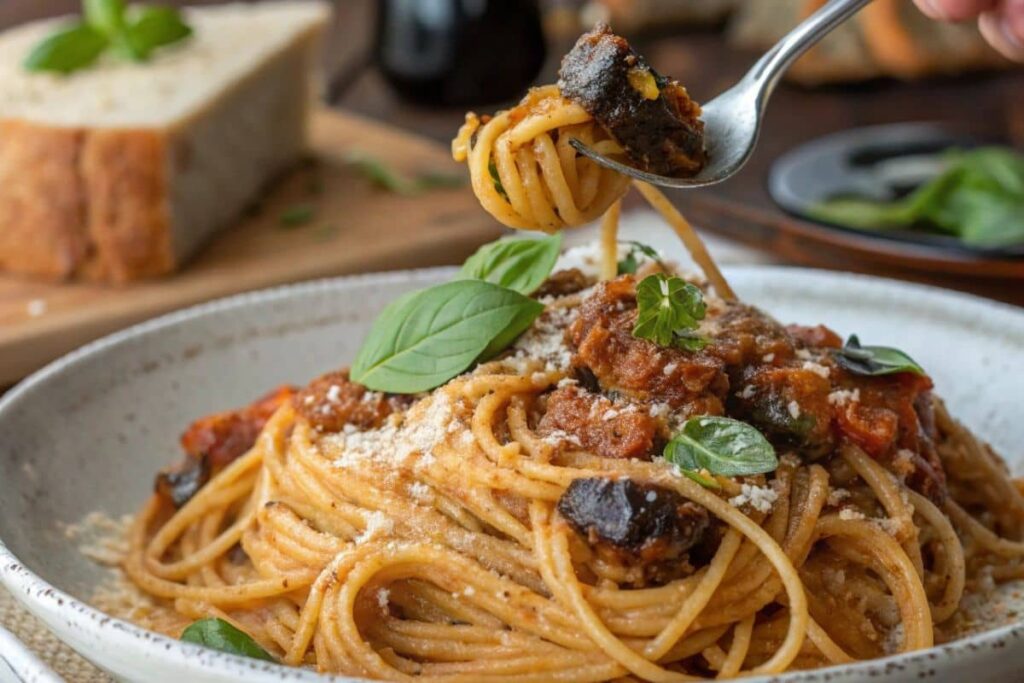
Ingredients:
- 1 large eggplant (cubed)
- 2 tablespoons olive oil
- 1 onion (chopped)
- 2 garlic cloves (minced)
- 1 can (14 oz) diced tomatoes
- ½ cup heavy cream
- ½ teaspoon red pepper flakes (optional)
- Salt and pepper to taste
- 300g spaghetti or your favorite pasta
- Fresh basil (for garnish)
Instructions:
- Preheat your oven to 400°F (200°C). Spread the cubed eggplant on a baking sheet, drizzle with 1 tablespoon of olive oil, and roast for 20 minutes, stirring halfway through.
- Cook the pasta according to package instructions. Reserve ½ cup of pasta water before draining.
- Heat the remaining olive oil in a skillet over medium heat. Sauté the onion until soft, then add garlic and cook for 1 minute.
- Add the diced tomatoes, roasted eggplant, and red pepper flakes. Simmer for 10 minutes, stirring occasionally.
- Blend the mixture with a handheld blender or in a food processor until smooth. Stir in the heavy cream and adjust seasoning with salt and pepper.
- Toss the sauce with the cooked pasta, adding reserved pasta water if needed to loosen the sauce.
- Garnish with fresh basil and serve immediately. This dish is creamy, flavorful, and an instant hit!
3. Eggplant Stir-Fry with Soy-Ginger Sauce
For a quick and easy weeknight meal, this stir-fry is a perfect choice. The tender eggplant cubes are coated in a savory soy-ginger sauce and paired with colorful veggies.
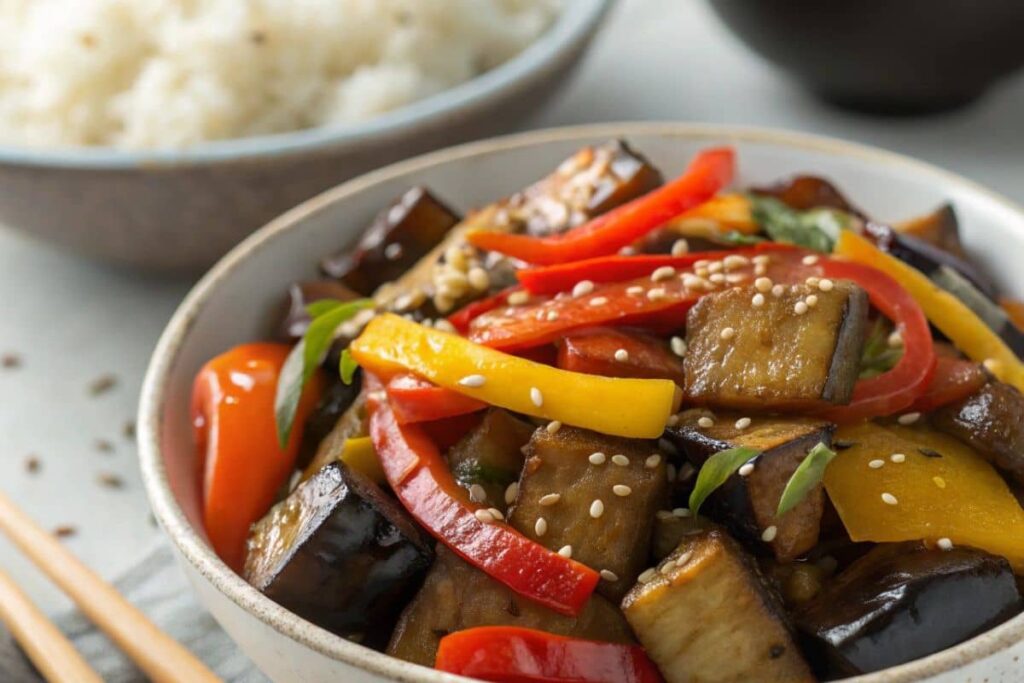
Ingredients:
- 2 medium eggplants (cubed)
- 1 red bell pepper (sliced)
- 1 carrot (julienned)
- 2 tablespoons vegetable oil
- 2 garlic cloves (minced)
- 1 tablespoon fresh ginger (grated)
- 3 tablespoons soy sauce
- 1 tablespoon hoisin sauce
- 1 teaspoon sesame oil
- Sesame seeds (for garnish)
- Green onions (chopped, for garnish)
Instructions:
- Heat the vegetable oil in a large skillet or wok over medium-high heat. Add the cubed eggplants and stir-fry for 5 minutes until lightly browned.
- Add the bell pepper and carrot to the skillet and cook for an additional 3-4 minutes until tender-crisp.
- In a small bowl, whisk together soy sauce, hoisin sauce, sesame oil, garlic, and ginger.
- Pour the sauce over the vegetables and toss to coat evenly. Cook for another 2-3 minutes, letting the sauce thicken slightly.
- Remove from heat, sprinkle with sesame seeds and chopped green onions, and serve hot over steamed rice or noodles. A flavorful, colorful dish that’s ready in minutes!
Frequently Asked Questions About Eggplant Ripeness
Can You Ripen an Eggplant After Picking?
Sadly, eggplants don’t significantly ripen once they’ve been harvested. This makes it essential to select an eggplant ripe enough when shopping at the store or market. If you’ve picked one that’s slightly underripe, you can try leaving it in a warm spot for a day or two—it may enhance the flavor a bit, but it’s no guarantee. Choosing the right eggplant from the start is always your best bet!
What’s the Difference Between Fresh and Ripe Eggplants?
Fresh eggplants are freshly picked but may not always be ripe. An underripe eggplant will feel firm and have a pale interior, which makes it less suitable for cooking. On the other hand, an eggplant ripe and mature provides the best flavor and texture, making it perfect for your recipes.
“A fresh eggplant isn’t always ripe, but a ripe eggplant is always fresh.”
Conclusion: Always Choose the Best Eggplants for Your Recipes
Picking an eggplant ripe enough might seem like a small detail, but it can transform your cooking. By focusing on the skin, stem, weight, and firmness, you’ll always select the perfect one for your meals. Whether you’re whipping up a creamy dip, grilling for a smoky flavor, or preparing a hearty pasta dish, a ripe eggplant will ensure your recipes shine every time.
So, the next time you’re browsing the produce section, use these tips to pick with confidence. A perfectly eggplant ripe choice will reward your efforts with delicious, flavorful dishes. Your taste buds will thank you!
Bringing It All Together
Fresh eggplants are a versatile ingredient that can transform your meals into something extraordinary. Whether you’re experimenting with a smoky grilled dish, blending it into a creamy pasta sauce, or tossing it in a flavorful stir-fry, the possibilities are endless. If you’re a fan of versatile ingredients like white eggplant, you might also enjoy exploring the bold flavors of blue cheese in your dishes or the creamy richness of Gouda cheese for a unique twist. Ready to elevate your cooking? Start with these recipes and let the magic of white eggplant inspire your next culinary adventure!
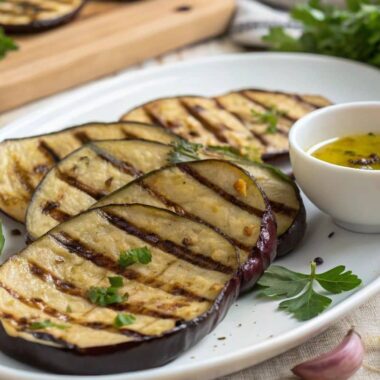
Grilled Eggplant with Garlic and Herbs
Ingredients
For Grilled Eggplant
- 2 medium eggplants Select ripe, glossy eggplants.
- 2 tablespoons olive oil For brushing the eggplants.
- 3 cloves garlic (minced) Adds flavor to the eggplant.
- 1 teaspoon dried oregano Can substitute with other herbs.
- 1 teaspoon salt Adjust to taste.
- ½ teaspoon black pepper Ground black pepper to taste.
- to taste fresh parsley (chopped) For garnish.
Instructions
Preparation
- Preheat your grill to medium heat.
- Slice the eggplants into ½-inch-thick rounds.
- In a small bowl, mix olive oil, minced garlic, oregano, salt, and pepper.
Cooking
- Brush the eggplant slices generously with the oil mixture on both sides.
- Place the slices on the grill and cook for 4-5 minutes per side, until they’re tender and have grill marks.
- Transfer to a serving plate, sprinkle with fresh parsley, and serve hot.

